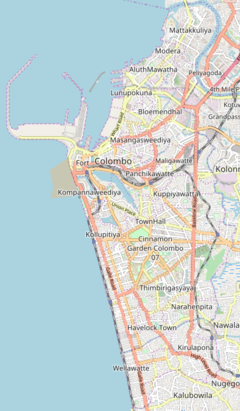| Colombo central bus station bombing | |
|---|---|
| Part of the Sri Lankan Civil War | |
  | |
| Location | Pettah, Colombo, Sri Lanka |
| Coordinates | 6°56′4.92″N 79°51′17.28″E / 6.9347000°N 79.8548000°E / 6.9347000; 79.8548000 |
| Date | April 21, 1987 (UTC+5:30) |
| Attack type | Car bombing |
| Deaths | 113-150 |
| Perpetrator | Eelam Revolutionary Organisation of Students and the Liberation Tigers of Tamil Eelam |
The Colombo central bus station bombing was the car bombing of the central bus terminal of Colombo carried out on April 21, 1987, in Pettah, Colombo, Sri Lanka. The 80-pound (36 kg) bomb killed at least 113 people and left a 10-foot (3 m) crater in the ground. The New York Times estimated 200 people had been injured.
The bombing, which was chosen specifically to land on the time of the day in order to harm as many people as possible, produced an enormous explosion that could be heard ten miles away. Six buses were trapped in the attack, causing numerous passengers to die in the fire as their buses burned. Heavy rainfall delayed rescue workers from arriving to the scene at time. Heaps of victims, including old people and children lay on the ground in agony before they were received by authorities.
The Bank of Ceylon Pettah branch was also heavily damaged during the attack. The attack had been attributed to the Tamil militant groups, EROS and the LTTE.
Aftermath
After the bombing, strict security measures were undertaken, including a curfew on the entire district, and the army prevented people from entering the areas affected by the attack.
In the immediate aftermath, Sinhalese mobs rioted across the streets of Colombo, pulling over cars to see if there were Tamils inside. Sri Lankan police led a massive intervention against rioters after some started stoning Tamil-owned stores, leading to heavy police presence in every corner of the city. The riots were eventually dispersed.
See also
References
- Sabaratnam, T (1996). The Murder of a Moderate: Political biography of Appapillai Amirthalingam. Dehiwela: Nivetha Publishers. p. 370.
- ^ "CHRONOLOGY-Major bombings in Sri Lanka blamed on Tamil Tigers". Reuters. 6 October 2008. Retrieved 18 April 2024.
- "Timeline of the Tamil conflict". BBC. September 4, 2000. Retrieved 2008-04-30.
- "Sri Lankan police hold doctor in car bombing". United Press International. April 28, 1987. Retrieved 2019-03-13.
- Refugees, United Nations High Commissioner for. "Refworld | Sri Lanka: Information on a LTTE bomb attack on the Colombo bus station in 1987". Refworld. Retrieved 2022-01-07.
- ^ Rettie, John (2009-04-21). "From the archive: Colombo bus station bomb claims 150, 22 April 1987". the Guardian. Archived from the original on 2013-09-06. Retrieved 2022-01-07.
- ^ "Car Bomb Kills Close to 150 at Crowded Sri Lanka Bus Depot : 200 Wounded in Colombo Attack During Rush-Hour". Los Angeles Times. 1987-04-21. Archived from the original on 2021-04-21. Retrieved 2022-01-07.
- Sabaratnam, T (1996). The Murder of a Moderate: Political biography of Appapillai Amirthalingam. Dehiwela: Nivetha Publishers. p. 370.
External links
| Sri Lankan civil war (1983–2009) | |||||||||||||||||||||||||
|---|---|---|---|---|---|---|---|---|---|---|---|---|---|---|---|---|---|---|---|---|---|---|---|---|---|
| Origins | |||||||||||||||||||||||||
| Combatants | |||||||||||||||||||||||||
| Phases | |||||||||||||||||||||||||
| Major battles |
| ||||||||||||||||||||||||
| Major events |
| ||||||||||||||||||||||||
| Leaders |
| ||||||||||||||||||||||||
| Aftermath | |||||||||||||||||||||||||
| Related topics | |||||||||||||||||||||||||
| |||||||||||||||||||||||||
- 1987 murders in Sri Lanka
- 20th century in Colombo
- 1987 building bombings
- April 1987 events
- April 1987 events in Asia
- 1987 road incidents
- Attacks on bus stations in Asia
- Attacks on civilians attributed to the Liberation Tigers of Tamil Eelam
- Building bombings in Sri Lanka
- Car and truck bombings in Sri Lanka
- Explosions in Colombo
- Liberation Tigers of Tamil Eelam attacks against buses
- Liberation Tigers of Tamil Eelam attacks in Eelam War I
- 1980s massacres of the Sri Lankan civil war
- Mass murder in 1987
- Mass murder in Colombo
- Mass murder of Sinhalese
- Terrorist incidents in Colombo
- Terrorist incidents in Sri Lanka in 1987
- Car and truck bombings in the 1980s
- Attacks on bank buildings in Asia
- 1987 riots
- Ethnic riots
- Riots and civil disorder in Sri Lanka